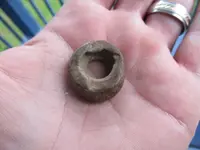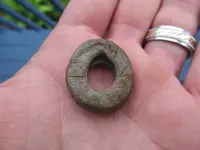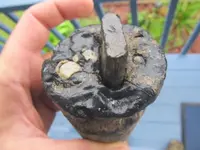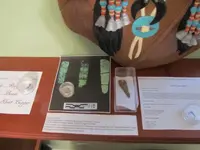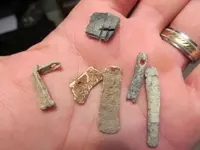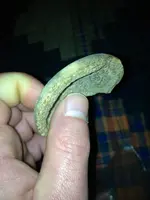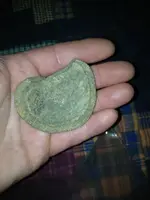You are using an out of date browser. It may not display this or other websites correctly.
You should upgrade or use an alternative browser.
You should upgrade or use an alternative browser.
Any one know what these are??
- Thread starter NC field hunter
- Start date
Harry Pristis
Bronze Member
- Joined
- Feb 5, 2009
- Messages
- 2,353
- Reaction score
- 1,297
- Golden Thread
- 0
- Location
- Northcentral Florida
If this is made of tar, it may be a seal placed around a line or other shipboard appurtenance to keep water from entering the vessel. I have found these in rivers, always near the coast. All the volatiles are gone, and the material is hard, lightweight, brittle, and jet-black.
NC field hunter
Silver Member
- #3
Thread Owner
Not tar, stone.??. Weird huh ?
Sent from my iPhone using TreasureNet
Sent from my iPhone using TreasureNet
SemperFind
Jr. Member
- Joined
- Jul 25, 2012
- Messages
- 53
- Reaction score
- 64
- Golden Thread
- 0
- Primary Interest:
- All Treasure Hunting
That's how baby rocks are made.
NC field hunter
Silver Member
- #5
Thread Owner
SemperFind said:That's how baby rocks are made.
Oh yeah. Sorry to have posted such a graphic scene.
Sent from my iPhone using TreasureNet
it's a pot hanger and a fossil donut.
timekiller
Silver Member
- Joined
- Feb 10, 2009
- Messages
- 3,852
- Reaction score
- 964
- Golden Thread
- 1
- Location
- Morehead City / Newport NC
- 🥇 Banner finds
- 1
- Detector(s) used
- Minelab E-Trac
- Primary Interest:
- All Treasure Hunting
If it's stone then all I can do is give a idea for you.Could be a net weight much like the lead one in my hand below,found on a colonial site (river).
What Harry describes sounds like parts of old battery cells.I've hunted rivers all my life & the only objects I find on regular basis like that are battery cell parts from early batteries.Pic.also below................
Take Care,
Pete,
What Harry describes sounds like parts of old battery cells.I've hunted rivers all my life & the only objects I find on regular basis like that are battery cell parts from early batteries.Pic.also below................
Take Care,
Pete,

Attachments
timekiller
Silver Member
- Joined
- Feb 10, 2009
- Messages
- 3,852
- Reaction score
- 964
- Golden Thread
- 1
- Location
- Morehead City / Newport NC
- 🥇 Banner finds
- 1
- Detector(s) used
- Minelab E-Trac
- Primary Interest:
- All Treasure Hunting
What Harry talks about sounds just like what I find.And as mentioned above they are from early carbon cell batteries Late 1800's early 1900's.The part he describes would be the seal in the top.They were made from asphalt saturated paper Or wax.They can have a doughnut hole from the carbon rod or they can have the slit type hole in them from the carbon rod type like the one above.
But without Harry posting what he finds to see this is just my guess based on what he describes.
Take Care,
Pete
Electrochemistry Encyclopedia -- Nonrechargeable batteries
But without Harry posting what he finds to see this is just my guess based on what he describes.
Take Care,
Pete
Electrochemistry Encyclopedia -- Nonrechargeable batteries
Attachments
capsmith
Sr. Member
I think the first picture is a artifact, maybe some sort of grinding tool. The other maybe just a rock.I just dont see any battery parts.
Harry Pristis
Bronze Member
- Joined
- Feb 5, 2009
- Messages
- 2,353
- Reaction score
- 1,297
- Golden Thread
- 0
- Location
- Northcentral Florida
What Harry talks about sounds just like what I find.And as mentioned above they are from early carbon cell batteries Late 1800's early 1900's.The part he describes would be the seal in the top.They were made from asphalt saturated paper Or wax.They can have a doughnut hole from the carbon rod or they can have the slit type hole in them from the carbon rod type like the one above.
But without Harry posting what he finds to see this is just my guess based on what he describes.
Take Care,
Pete
Electrochemistry Encyclopedia -- Nonrechargeable batteries
That's an interesting possibility, Pete. I can't make a strong argument one way or the other 'cause I doubt I could find an example in my extensive accumulation of oddments from the rivers.
I just remember being puzzled by the nature of the tar rings, and later finding a satisfactory explanation for them. The tar was preserved as it was applied, though it was hard, light, and brittle after losing all its volatile components.
I think the tar rings were not cast in a cylinder, nor was the opening tab-shaped or rectangular . . . such would have provided clues to usage that I just didn't have. I have found many carbon rods used as battery terminals, but they never were associated with a tar ring.
But, this doesn't help ID a stone ring such as 'NC...' describes. What do you suppose that ring is?
timekiller
Silver Member
- Joined
- Feb 10, 2009
- Messages
- 3,852
- Reaction score
- 964
- Golden Thread
- 1
- Location
- Morehead City / Newport NC
- 🥇 Banner finds
- 1
- Detector(s) used
- Minelab E-Trac
- Primary Interest:
- All Treasure Hunting
I did not say his piece was from a battery.I did say it could be a net weight like the lead one I found if nothing else.The battery deal was being talked about because Harry said he finds them all the time.And from what he described sounded like battery seals.The lead weight I found was from a contact period colonial site because I've found other lead & copper items there such as pendants,trade beads,etc.So mine could be native algonquin tribe or colonial.But I'm sure it was a net weight & a old one too.Here's some better pics. with some of the other items that were found.The battery cell was found elsewhere & have found quite a few.
Attachments
timekiller
Silver Member
- Joined
- Feb 10, 2009
- Messages
- 3,852
- Reaction score
- 964
- Golden Thread
- 1
- Location
- Morehead City / Newport NC
- 🥇 Banner finds
- 1
- Detector(s) used
- Minelab E-Trac
- Primary Interest:
- All Treasure Hunting
Yes Harry they fooled me for years (battery seals).Because of the shape they came in also they can look like clay as well which draws the trained eye to them.But after I found some still attatched like the one in the pics. it became clear then on for me.Also the location always seemed to be trashy late 1800's items around (most of the time)That's an interesting possibility, Pete. I can't make a strong argument one way or the other 'cause I doubt I could find an example in my extensive accumulation of oddments from the rivers.
I just remember being puzzled by the nature of the tar rings, and later finding a satisfactory explanation for them. The tar was preserved as it was applied, though it was hard, light, and brittle after losing all its volatile components.
I think the tar rings were not cast in a cylinder, nor was the opening tab-shaped or rectangular . . . such would have provided clues to usage that I just didn't have. I have found many carbon rods used as battery terminals, but they never were associated with a tar ring.
But, this doesn't help ID a stone ring such as 'NC...' describes. What do you suppose that ring is?
I hope this has shead some light on them a little for you.
Take Care,
Pete,

NC field hunter
Silver Member
- #15
Thread Owner
Man, if it is led, it is really light, but could be. It could just be a washed out old rock, but it was found a little ways from water. However, creeks and streams are rapidly being filled in or running dry around here. Thanks guys for the in put .
timekiller
Silver Member
- Joined
- Feb 10, 2009
- Messages
- 3,852
- Reaction score
- 964
- Golden Thread
- 1
- Location
- Morehead City / Newport NC
- 🥇 Banner finds
- 1
- Detector(s) used
- Minelab E-Trac
- Primary Interest:
- All Treasure Hunting
If it's light then it's not lead for sure.Did not know it was light.Just a few questions thenMan, if it is led, it is really light, but could be. It could just be a washed out old rock, but it was found a little ways from water. However, creeks and streams are rapidly being filled in or running dry around here. Thanks guys for the in put .
 Does it measure around 2.5 inches.Cause now you have me thinking it could be a old battery seal.They are light weight.I've seen some like yours sorta but mine are always found in the water so look a little different then yours.I'm not sure what one that has spent it's life on land would look like.But if it's light as you now say then I would have to question it being a rock also.I only suggested it was a net weight,cause it just reminded me so much of the one I had found in it's shape.Anyway thanks for the cool thread the other piece is very interesting in it's own right.
Does it measure around 2.5 inches.Cause now you have me thinking it could be a old battery seal.They are light weight.I've seen some like yours sorta but mine are always found in the water so look a little different then yours.I'm not sure what one that has spent it's life on land would look like.But if it's light as you now say then I would have to question it being a rock also.I only suggested it was a net weight,cause it just reminded me so much of the one I had found in it's shape.Anyway thanks for the cool thread the other piece is very interesting in it's own right.
Take Care,
Pete,

NC field hunter
Silver Member
- #17
Thread Owner
timekiller said:If it's light then it's not lead for sure.Did not know it was light.Just a few questions thenDoes it measure around 2.5 inches.Cause now you have me thinking it could be a old battery seal.They are light weight.I've seen some like yours sorta but mine are always found in the water so look a little different then yours.I'm not sure what one that has spent it's life on land would look like.But if it's light as you now say then I would have to question it being a rock also.I only suggested it was a net weight,cause it just reminded me so much of the one I had found in it's shape.Anyway thanks for the cool thread the other piece is very interesting in it's own right.
Take Care,
Pete,
It is 4 inches across. It is pretty hollowed out and wears it's mark of time. It may have been a weight in its prime. When I say light, I don't mean feather weight, but not lead heavy either. I once found a chunk of led , I suppose in its natural form, and it blew my mind how much that little "rock" weighed. You are probably correct on the net weight, I can see it being that heavy. Thank you for all the help
NC field hunter
Silver Member
- #20
Thread Owner
Similar threads
- Replies
- 8
- Views
- 713
- Replies
- 3
- Views
- 272
- Replies
- 4
- Views
- 330
Users who are viewing this thread
Total: 1 (members: 0, guests: 1)

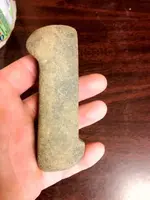
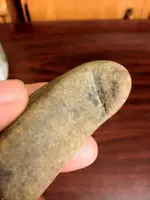
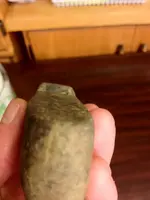
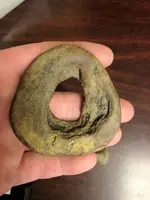
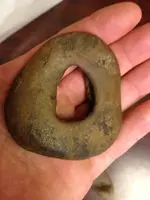
![000_0002[1].webp](/data/attachments/350/350461-f29e28c6eae9a0ffae2c78630442d2e8.jpg?hash=kqXU5NBf_0)
![000_0001[1].webp](/data/attachments/350/350441-feae50936e5aeee1453f16153b05d03c.jpg?hash=lJ_LPf_S8Y)
![001[1].webp](/data/attachments/635/635845-2a29dd9cf1d242ad58b69a1996a9c442.jpg?hash=pgKKUXhkA0)
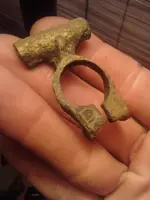
![b02-f02[1].webp](/data/attachments/637/637055-505c8c43ad3f6a408bad4760792944b9.jpg?hash=InQP2qdxb_)
![inside-dry-cell-apr-1959-pe-2[1].webp](/data/attachments/637/637052-bc7c1b192ffc52983ad21f8160674b5e.jpg?hash=8-bZUvmYYI)
